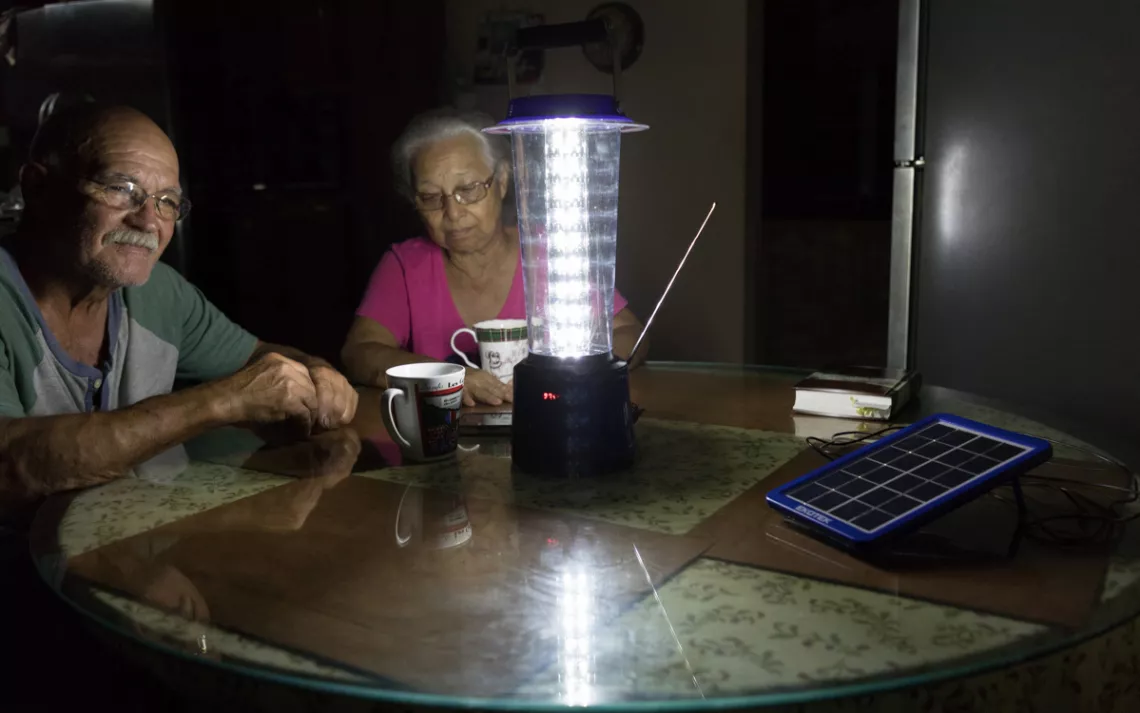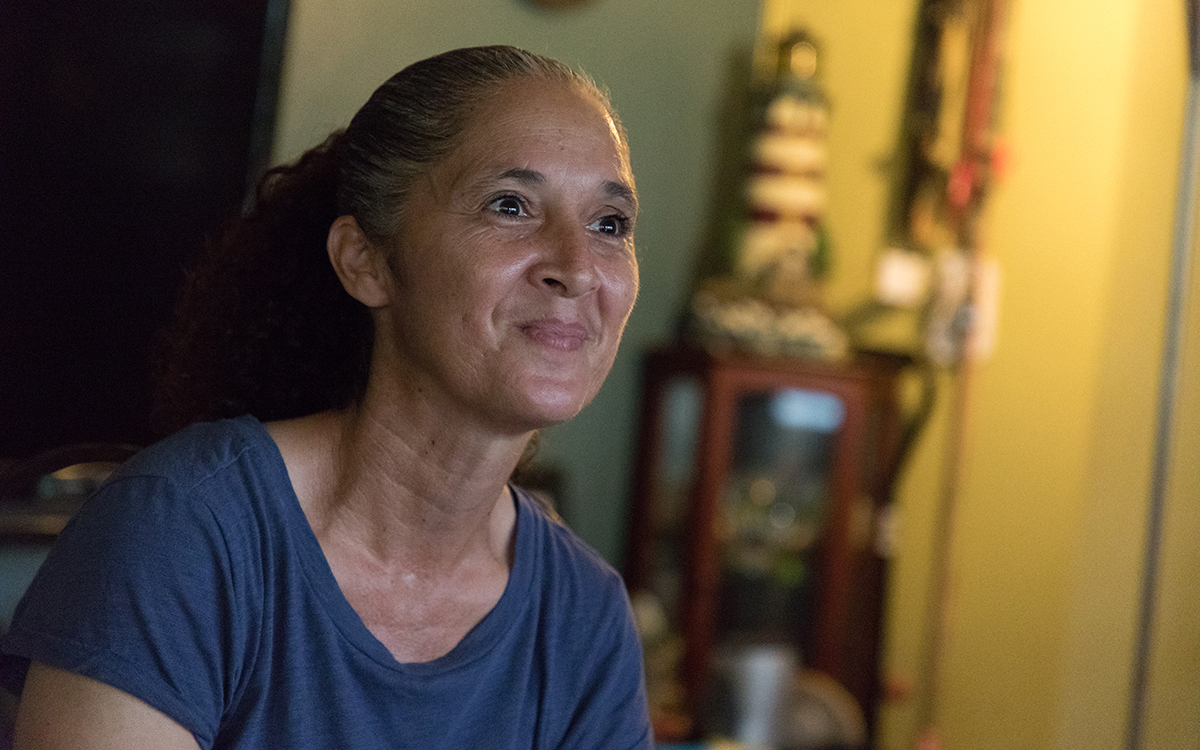Solar Lanterns Serve as Beacon of Hope for Puerto Rico
Sierra Club works with local partners to distribute solar lanterns and water filters

Juan Matta Rio Grande La Vega charging phone |Photos by Joa Rodríguez
Two months after Hurricane Maria knocked out power to most of Puerto Rico, gasoline and diesel generators have become household necessities for most people on the island. But the machines are noisy and emit toxic fumes, and some puertorriqueños can barely bring themselves to plug in their only source of energy. With costs as high as $600 a month for gasoline, generators are not a sustainable long-term solution for most households. But what else can residents do while they wait for electricity?
Solar-powered lanterns are one part of the answer.
The Sierra Club’s Hurricane Maria Response Team mobilized to get support to the U.S. territory as quickly as possible after the Category 4 storm made landfall on September 20. A donation from a solar energy entrepreneur and Sierra Club Foundation board member sparked an initiative to deliver solar lanterns to the hardest-hit areas of the island. A founding member of the Puerto Rico Chapter who is now based in New Mexico, Camilla Feibelman jumped at the news and quickly began working out the details with the response team, spearheaded by Adriana Gonzalez, the Club’s Puerto Rico–based environmental justice organizer.
Sending anything to Puerto Rico after the equivalent of a 50-mile-wide tornado wiped out much of the island’s infrastructure made for a serious logistical challenge. Especially since the ports had become clogged with traffic by all those trying to get supplies to the island. Taking heed of warnings of the congested port, Feibelman coordinated with contacts on the ground largely through Facebook (one of the only reliable communication platforms available to puertorriqueños in the weeks immediately after the storm) to arrange the first shipment of 1,000 solar lanterns by air. The Sierra Club’s deep network in Puerto Rico helped to get the lamps delivered to communities amid nearly impossible conditions.
Working directly with local partners like the Coalition for the Northeast Ecological Corridor (CEN), the Sierra Club is providing on-the-ground support to communities throughout Puerto Rico. One of the first people the response team made contact with was Cristóbal Jiménez, president of the coalition. Jiménez knew that the abandoned San Martín Elementary School, outside the town of Luquillo—which had been converted into a community center after it was shut down in the wake of the island’s 2015 debt crisis—would be the perfect central location for coordinating these efforts. “We knew what we needed to do,” Jiménez says. Jiménez and others had already started delivering hot meals to locals, and soon after they were bringing solar lanterns and water filters door-to-door, explaining how they work. “When you deliver a water filter and you see how this filter is really keeping this family safe and healthy, it means a lot,” says Jiménez.
To date, the CEN has delivered 780 lamps, and a shipment of 300 more is on its way. The solar lanterns have become a symbol of independence and community for many people. Residents are able to light their homes, charge their cellphones, and listen to their favorite radio programs without having to depend on the slow-moving government programs—and also without having to pay for gasoline to run their generators. At night, some families congregate around the solar lanterns, taking refuge in their light.
In La Vega, a small community at the gateway to El Yunque National Park, the Center for Conservation of the Landscape (Centro para la Conservación del Paisaje) has delivered solar lanterns to 74 of the 104 families living there. A local resident who works with the center, Madeline Matta, explains that power outages are not restricted to when hurricanes hit Puerto Rico. Her town is accustomed to being without power for hours at a time, sometimes even all night, whenever trees get tangled up in the transformers. “Well, since the hurricane, most of the trees that used to bother the transformers are gone,” Matta says with a mix of relief and sadness in her voice. “Although it’s a shame for the trees.”

Madeline Matta
The center is working with the community to develop strategies for eco-tourism. Ideas include building a bed-and-breakfast associated with El Yunque to attract park visitors to stay in the town and utilizing the abundant natural resources to create unique food products to sell to tourists. Matta says the residents of La Vega want more connection to El Yunque National Park and would like to see some economic benefits from its 1.5 million annual visitors. Community members, Matta says, strongly resist the ideas coming from the government, like building a huge hotel.
“There are so many problems,” Matta says, her voice trailing off as she reflects on the hardships she and her family have endured over the years. For a time after Hurricane Maria, candles provided light in her family’s well-kept pink home. But now, there are no candles left. After buying five boxes when the hurricane first hit, Matta has already run out. “They don’t last us any time at all,” she says. Batteries have become too expensive for her family, and thus their battery-powered lamps remain dark. And their kerosene lamps lack the fuel to function.
The solar lanterns are part of the solution for this rural mountain town and have brought a measure of independence to the small community, which may not have its power restored until May 2018. “At least the solar lanterns provide free light,” Matta says. “We put them outside in the morning, and they provide light for us through the evening.” She and her colleagues at the center have been delivering the lanterns to local residents for weeks. Working out of Matta’s home, the center is a beacon of hope for the community, much like the tiny decorative lighthouses placed around Matta’s blank TV set.
Another Puerto Rican partner, Casa Pueblo, helped the Sierra Club get one of the first shipments of solar lanterns delivered to the homes of a heavily impacted area—the town of Adjuntas. Founded in 1980, Casa Pueblo has been fighting harmful mining projects and protecting local communities for decades. When Hurricane Maria hit, Casa Pueblo started an emergency campaign to deliver solar lanterns to as many homes as possible in the hard-hit interior. The Sierra Club quickly joined the campaign. Casa Pueblo transported the solar lamps from the main airport in San Juan to Adjuntas, where Casa Pueblo volunteers went door-to-door delivering them to local residents.
In the medium-to-long term, renewable energy could potentially help Puerto Rico become more energy-self-sufficient and climate-resilient. But leadership at the Sierra Club and the Sierra Club Foundation recognize that now is the time for recovery, and the focus remains on getting the island’s struggling population what they need to survive. “Puerto Rico is dealing with the real impacts of the climate disasters that are going to be increasingly more common,” says Dan Chu, director of the Sierra Club Foundation. Sierra Club members donated over $1.2 million for Maria recovery within two weeks of the hurricane’s landfall. “Our members care very much about our fellow human beings and recognize that we are part of the environment,” Chu says. The Hurricane Maria Response Team continues to work on getting as many new shipments of solar lanterns and water filters to the island as possible.
“I see the need to give the people hope,” Jiménez says. For him, the most important thing now is to provide puertorriqueños with the hope that tomorrow is going to be better. For him, delivering these lanterns and filters is one way to deliver that hope and to help prepare residents to be more resilient in future climate disasters.
Jason Mark contributed reporting from Puerto Rico.
 The Magazine of The Sierra Club
The Magazine of The Sierra Club



